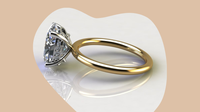Is White Gold a Good Choice for an Engagement Ring?
White gold is amongst the most desired choices of metal for engagement rings. It’s white, radiant shine lets off undeniable sheen and is neutral enough to be worn with any gemstone colour and existing jewellery collection.
If you’re unsure about whether white gold engagement ring is the right choice for you however, continue reading to understand exactly what the precious type of metal is and the pros and cons to having it as your engagement ring metal.
What is white gold?
White gold is a lustrous metal type that has a long-standing reputation in the jewellery world. It is used for every jewellery type and has become one of the most timeless metals of them all.
However, much of the mystery around white gold that leaves people wondering, is whether it is actually gold. The metal is in fact formed by combining yellow gold with other alloys such as nickel, palladium and silver. The palladium and silver are what give the gold its white lustre and shiny finish, and why white gold has that soft, warm undertone to it. Without these alloys, the metal would be too malleable for jewellery use and soften very quickly.
White gold quality & purity
White gold has different levels of purity which is determined by the amount of gold it contains. Jewellers will state the purity level by carat weight. The carat weight shows the quantity of gold that has been used in the jewellery piece. The most common carat numbers you’ll see in engagement rings is usually 9ct, and 18ct. 9ct signifies around 37.5% gold in the jewellery, and 18ct contains 75% pure gold. The more gold, the higher the carat.
However, the higher the carat, the softer the overall piece as it has less alloyed nickel, palladium and silver within it. Therefore, if you’re looking for a white gold ring that is highly durable and resistant to everyday knocking and wear, then opting for a lower carat will be best.
How to care for your white gold ring
Like any piece of jewellery, with the right tender, love, and care, you can have a piece that will look beautiful forever.
To clean your white gold engagement ring, simply create a cleaning solution by mixing mild soap with warm water. Avoid using harsh chemical products such as detergents. Then, soak your ring in the solution for around 20-30 minutes. Once soaked, we recommend using a soft cloth to remove any dirt that exists on the ring including around the centre stone.
Once complete, rinse the ring with lukewarm water to remove any residue and dry with a clean towel. Repeating this every 2-3 months will allow your ring to shine bright forever.
Pros and cons of white gold engagement rings
Let’s take a look at white gold in more detail by comparing its pros and cons for use in an engagement ring:
|
Pros |
Cons |
|
Less expensive than platinum, while still possessing a bright, white shine |
Less durable than some other metals due it to being softer |
|
Wider selection of rings available due to it being a popular metal choice |
Can turn yellow over time if not rhodium plated every 2-3 years |
|
Compliments every gemstone and skintone |
Non-hypoallergenic |
As we can see, the advantages and disadvantages are pretty even. However, we believe that with the right care, then a white gold ring can be lovingly cherished forever. You also have a good chance at finding a ring that is right for you given the extensive selection of white gold engagement rings on the market. However, allergy sufferers may be better suited to a different metal choice such as platinum.
How long will a white gold ring last?
White gold engagement rings can have a long life, just like a ring in any other metal, so long as it is cared for in the correct way. It is natural for its plating to fade over time, but usually this takes around 6 months to happen, if not longer. When this occurs, you can simply go to a trusted jeweller to have your ring re-plated or dipped.
With an expert eye looking at your ring, you will also be able to prevent any damage to the stones, as the specialist skills and tools will pick up on any damage to the finer details. Therefore, a yearly service, such as what we offer here at Rocks, is a great way to ensure your engagement ring lasts a lifetime.
What is better for an engagement ring; yellow gold or white gold?
Whether yellow or white gold is better for your engagement ring is all down to personal preference.
Yellow gold is mixed with silver, zinc, nickel, copper, and sometimes palladium. Therefore, if you were to choose between an 18ct yellow gold ring, or a 18ct white gold ring, the gold content would be the exact same, the only difference would be the colour.
White gold is also more durable than yellow gold due to the particular alloys its is mixed with, but yellow gold is easier to maintain and resize should you ever need to. Similarly, yellow gold has more of a traditional and vintage appeal, whereas white gold is more modern, with a contemporary, silvery look. And depending on your centre stone, you may prefer one metal colour over the other.
With benefits and compromises with both types of metal, the choice is simply a case of personal taste.
Is white gold cheaper than platinum?
White gold is less expensive to buy than platinum, by roughly 40-50%. This is because more platinum is needed to make a piece of jewellery compared to the amount required for a white gold piece of a similar size and style.
What’s more, platinum is always used in its purest form, meaning it does not need to be mixed with other metals to be able to make the jewellery. It is also much rarer than white gold, which gives it a desirability and therefore, a higher price tag.
However, to many, it is hard to notice a difference between white gold and platinum, so many gravitate towards white gold because it is cost effective while still possessing a similar look of luxury and expensive finish as platinum.
Does my white gold ring need to be rhodium plated?
Due to the mixing of alloys needed to create white gold jewelley, the presence of yellow gold means white gold will never be entirley white. To achieve the ultra-white sheen the metal is known for, it needs to be rhodium-plated with another metal, often platinum.
Overtime, however, this plating will thin with everyday wear and the ring will need to be re-plated to retain its white sheen. Usually it is recommended to do this every 2-3 years to ensure your ring is in the best condition at all times.
By now, we’ve hopefully explained the many benefits and a few points to consider when choosing a white gold engagement ring. It comes as no surprise that it is the most popular metal choice for engagement rings, and we believe it is an incredibly versatile choice, that would be perfect for your ring.
If you still have any concerns, questions, or queries on white gold engagement rings, or engagement rings in general, do not hesitate to get in touch with our team, where one of our experts can help guide and assist you on your engagement ring journey.


